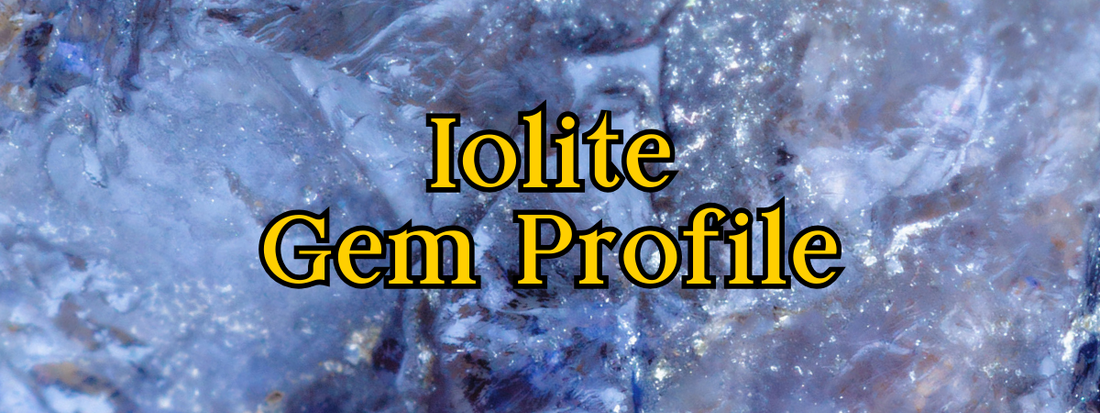
A Jeweller’s Guide to Iolite: Identification, Setting and Cleaning Tips
Step into the mesmerising world of iolite, a gemstone that once guided ancient sailors across treacherous waters. With its shifting blue-violet hues and intriguing optical effects, iolite is a captivating choice for jewellers and collectors alike.
Whether you're designing a delicate pendant or a bold statement ring, this gem brings both beauty and history to your creations.
In this guide, we’ll cover everything you need to know about iolite, from its defining characteristics and care requirements to setting considerations and etymology.
Ready to set sail on this gemstone journey? Let’s dive in!
 Basic Identification Information
Basic Identification Information
Name & Synonyms
Iolite; also known as "water sapphire", "the poor man's sapphire" or "Vikings' compass."
Species
Cordierite
Colour Range
Shades of violet-blue to greyish-blue, with strong pleochroism showing yellow, brown, or clear tones from different angles.
Refractive Index
1.522–1.596
Birefringence
0.005–0.018
Optical Sign
Biaxial
It can be either + or -, but usually -
Specific Gravity
2.58–2.66
Fluorescence
None
Lustre
Vitreous, giving it a brilliant, glassy appearance.
Clarity
Type II
Most iolites are eye-clean but can contain needle-like inclusions or internal fractures.
Gems Often Mistaken for Iolite
Tanzanite, Tourmaline, Sapphire, Spinel, Kyanite
Mohs Hardness
7–7.5
Wearability
Good, but prone to cleavage and fractures if struck hard.
Birthstone
An alternative birthstone for September.
 Common Treatments
Common Treatments
Iolite is one of those rare stones that is generally left untreated, though very occasionally it will be heated to enhance the colour.
 Durability Considerations
Durability Considerations
Iolite has decent scratch resistance level but also contains perfect cleavage, meaning it can break if knocked in just the right (or wrong) way. This makes it a little trickier for jewellers who work with prong settings or exposed designs. It’s best suited for pendants or earrings.
If setting into a ring or bracelet protection is an important consideration as they're far more likely to get knocked when being worn.
 Jeweller's Setting Tips
Jeweller's Setting Tips
Iolite’s pleochroism (its ability to show different colours from different angles) makes orientation key when setting the stone. Set it incorrectly, and the gemstone may look dull or washed out.
Since iolite has cleavage, avoid tension settings or exposed corners. A bezel or halo setting helps protect it from accidental knocks.
Iolite isn't suitable for casting in place as sudden temperature changes can cause fractures.
 Care Instructions
Care Instructions
Iolite is fairly low-maintenance but needs a gentle touch. Here’s how to keep it looking its best.
Use lukewarm water, mild soap, and a soft brush for cleaning.
Avoid ultrasonic cleaners, as vibrations can worsen any existing fractures.
Steam cleaners are a no-go as high heat can cause cracks.
Store separately from harder gemstones like sapphires and diamonds to prevent scratches.
 Aesthetic & Design Insights
Aesthetic & Design Insights
Iolite’s deep blue-violet hues create a stunning (and more affordable) alternative to sapphire or tanzanite.
Its colour pairs beautifully with:
Silver, White gold or platinum for a modern, sleek look.
Yellow gold to enhance its subtle violet undertones.
Set iolite along side moonstones, white sapphires, or diamonds to add a touch of brilliance to your designs.
 Market & Ethical Notes
Market & Ethical Notes
Iolite is widely available and generally considered an ethical choice. It is often sourced from India, Sri Lanka, Brazil, and Madagascar, with many mines following responsible mining practices.
Value is determined by colour and clarity. The most prized iolites display a strong, saturated blue-violet hue without a greyish tone.
 Metaphysical Properties
Metaphysical Properties
For those who love the mystical side of gemstones, iolite is believed to enhance intuition, inner vision, and clarity of thought. Some say it helps with decision-making and self-discovery, making it a favourite for creatives and deep thinkers.
 Etymology
Etymology
The name "iolite" comes from the Greek word "ios," meaning violet.
 Iolite may not be as famous as sapphire or tanzanite, but its affordability, fascinating pleochroism, and deep, moody hues make it a hidden gem worth considering. Whether you're crafting jewellery or simply admire gemstones, iolite is a great addition for your collection!
Iolite may not be as famous as sapphire or tanzanite, but its affordability, fascinating pleochroism, and deep, moody hues make it a hidden gem worth considering. Whether you're crafting jewellery or simply admire gemstones, iolite is a great addition for your collection!

Want to read more about iolite gemstones? Here are my other iolite themed topics:
